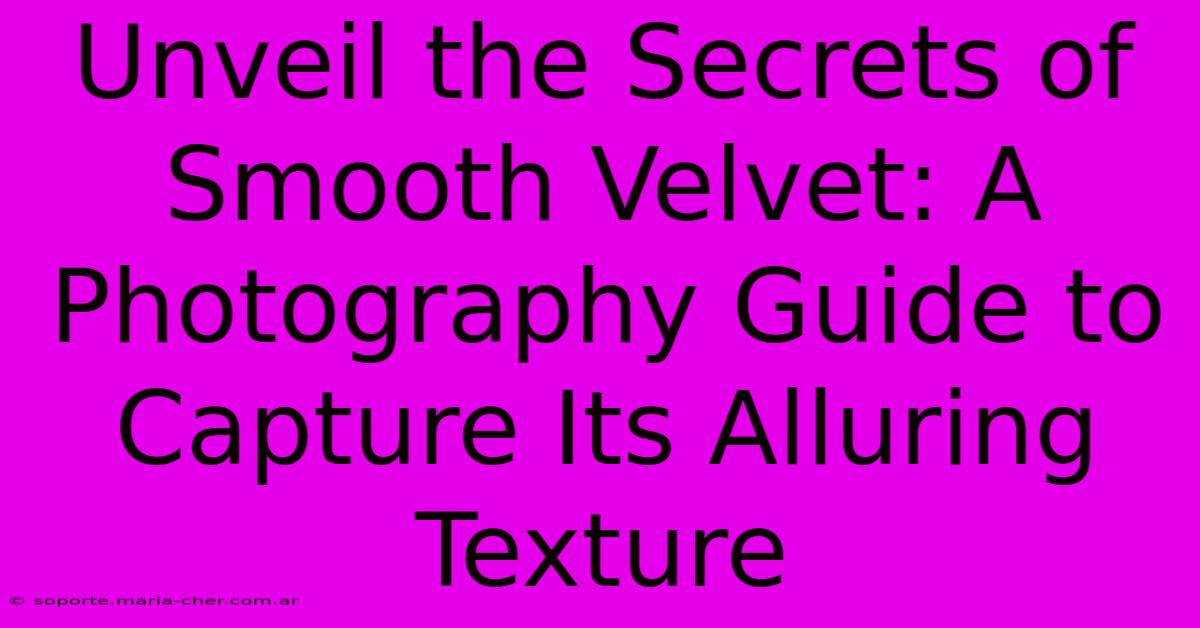Unveil The Secrets Of Smooth Velvet: A Photography Guide To Capture Its Alluring Texture

Table of Contents
Unveil the Secrets of Smooth Velvet: A Photography Guide to Capture Its Alluring Texture
Velvet. The very word conjures images of luxury, richness, and a captivatingly smooth texture. Photographing velvet, however, presents unique challenges. Its deep pile and subtle sheen can be tricky to capture accurately, often resulting in images that fall flat and fail to convey the material's true allure. This guide will unveil the secrets to photographing velvet and help you create stunning images that truly showcase its captivating texture.
Understanding the Challenges of Velvet Photography
Before diving into techniques, let's address the hurdles:
- The Pile: Velvet's plush pile scatters light, leading to uneven illumination and potentially muddy colors. Direct flash can exacerbate this, creating harsh highlights and dark shadows.
- Subtle Sheen: Velvet's delicate sheen adds to its beauty, but it can be difficult to capture without over-exposing highlights or losing detail in the darker areas.
- Color Accuracy: The rich, deep colors of velvet are a key part of its appeal. Accurately representing these colors in your photographs is crucial.
Mastering the Art of Velvet Photography: Techniques and Tips
Here's how to overcome these challenges and capture the true essence of velvet:
1. Lighting is Key: Diffused is Best
Avoid direct flash. The harsh light will flatten the texture and create unappealing highlights. Instead, opt for soft, diffused lighting. This could involve using:
- Softboxes: These create a soft, even light that minimizes harsh shadows.
- Diffusers: Place diffusers over your existing light sources to soften the light.
- Natural Light: Soft, indirect natural light is ideal, especially on an overcast day. Avoid harsh midday sun.
Experiment with lighting angles. Side lighting can accentuate the texture and create subtle shadows that highlight the pile. Backlighting can beautifully showcase the sheen, but careful exposure control is vital.
2. Camera Settings for Velvet Success
- Aperture: A relatively narrow aperture (f/5.6 to f/8) will help ensure sharp focus throughout the image, especially important for showcasing texture details.
- Shutter Speed: Choose a shutter speed fast enough to prevent blur, especially if you're using natural light that might fluctuate.
- ISO: Keep your ISO as low as possible to minimize noise and maintain image quality.
- White Balance: Accurate white balance is crucial for capturing the true colors of the velvet. Use a custom white balance setting if necessary.
3. Styling and Composition for Maximum Impact
- Background: Choose a simple, uncluttered background that complements the velvet's color and texture without distracting from the subject. A neutral-colored backdrop works well.
- Props: Consider using minimal props to add context or visual interest without overwhelming the velvet.
- Angles: Experiment with different angles and viewpoints to find the most flattering perspective. Close-up shots can beautifully showcase the texture, while wider shots can capture the overall drape and flow of the fabric.
4. Post-Processing for Perfection
Subtle post-processing can enhance your velvet photographs:
- Adjustments: Fine-tune brightness, contrast, and saturation to optimize the colors and texture.
- Sharpening: Carefully sharpen the image to enhance the detail without introducing artifacts.
- Noise Reduction: If necessary, apply noise reduction to minimize any graininess.
Beyond the Basics: Creative Approaches
Don't be afraid to experiment! Try these creative approaches:
- Macro Photography: Get incredibly close to capture the intricate details of the velvet's weave.
- Silhouettes: Use backlighting to create dramatic silhouettes of velvet objects.
- Water Droplets: Add water droplets to the velvet for a unique textural effect.
Conclusion: Unlock the Velvet's Allure
Mastering velvet photography requires attention to detail and a willingness to experiment. By understanding the challenges and applying the techniques outlined above, you can capture the rich colors, luxurious texture, and captivating sheen of velvet, creating stunning images that truly showcase its allure. Remember, practice makes perfect! So grab your camera, some velvet, and start experimenting. You'll be amazed at the beautiful results you can achieve.

Thank you for visiting our website wich cover about Unveil The Secrets Of Smooth Velvet: A Photography Guide To Capture Its Alluring Texture. We hope the information provided has been useful to you. Feel free to contact us if you have any questions or need further assistance. See you next time and dont miss to bookmark.
Featured Posts
-
Empower Your Intuition With Visconti Sforza A Tarot Journey To Wisdom
Feb 07, 2025
-
Unlock The Power Of Typography Align Your Text To Success
Feb 07, 2025
-
No Te Pierdas Esto El Metodo Infalible Para Mantener La Calidad De Las Imagenes En Conversiones Webp A Jpg
Feb 07, 2025
-
Step Into The Monochrome Uncover The Magic Of Black And White At These Hidden Gems
Feb 07, 2025
-
Blast Off Into Space Design A Galaxy Themed Invitation To Blow Him Away
Feb 07, 2025
